Christmas Cactus Care Guide + Growing Tips
We’ve made Christmas cactus care easy by sharing all the important details of caring for your plant.
Festive and cheerful, holiday cactus overflow with colorful flower buds just in time for the holiday season.
The ever popular Christmas cactus are fairly easy to grow and widely adored for their exotic, bright flowers.
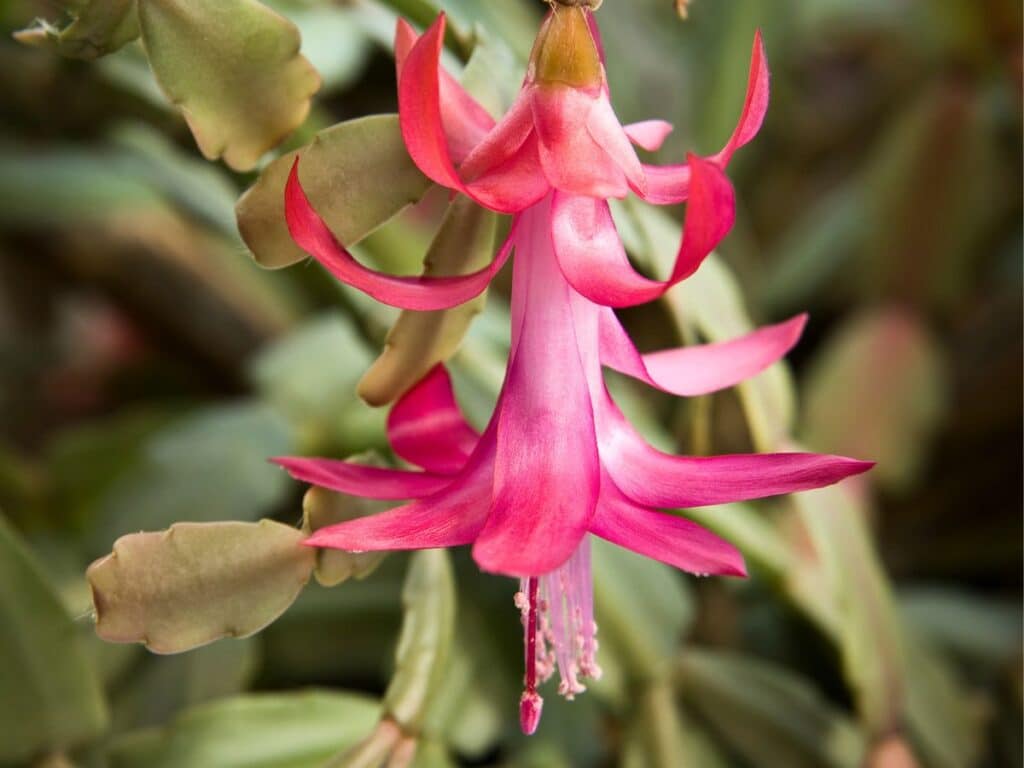
Though they are generally low maintenance, these Christmas plants do need well-draining soil in order to prevent root rot. They also crave high humidity and indirect but bright light. And in order to get their buds to set you must get one key thing right!
Luckily, we’re dishing it all on these dashing delightful cacti – join us so you can give your new plants perfect growing conditions.
If we haven’t met, my name is Jamie and I’ve been a houseplant enthusiast for over a decade. Let me share my experience growing Christmas cactus with you here.
About
Christmas cacti are known as Schlumbergera bridgesii in Latin.
Also referred toa short day plants, the cacti produces new leaf growth in the warm summer months, then needs cooler temperatures and shorter days to set buds in the fall.
Christmas cactus bloom in late fall to mid winter with beautiful flowers in various shades of pink, red and white.
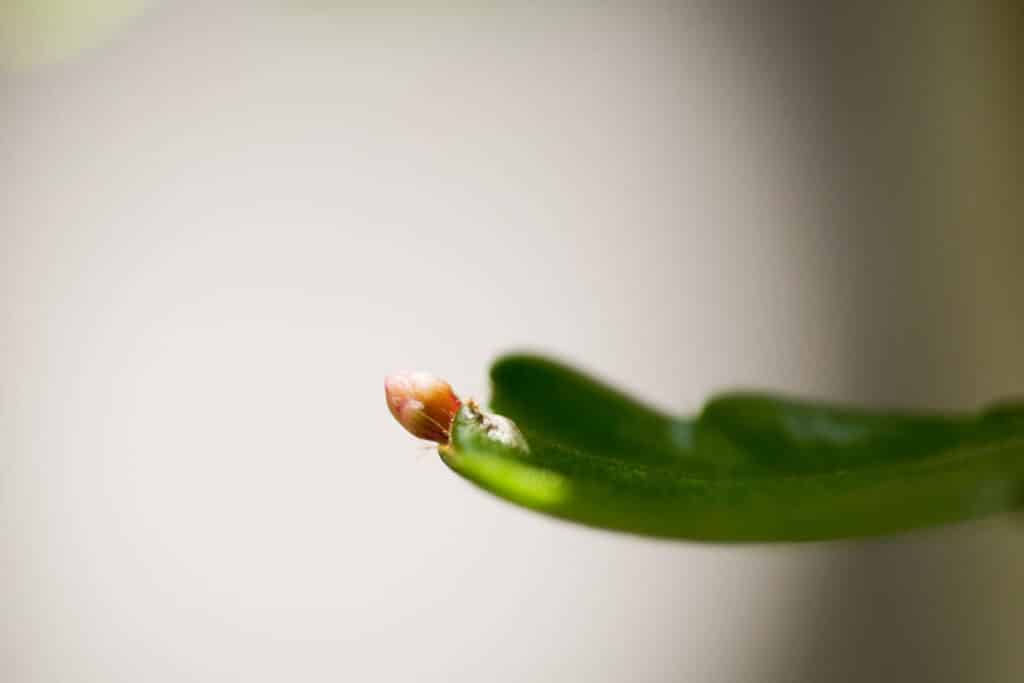
These beautiful holiday houseplants feature cascading green clades (leaves), and distinctive winter flowers featuring purple anthers.
The leaf segments are flat and feature scalloped edges, as opposed to a Thanksgiving cacti which have pointed leaf clades. (Learn all about the differences between the two plants here).
These tropical cactus find their native homes in the shaded, humid rain forests of Brazil. Like air plants, they are epiphytic, growing off the bark of tree branches and in decaying matter found in crevices of rocks.
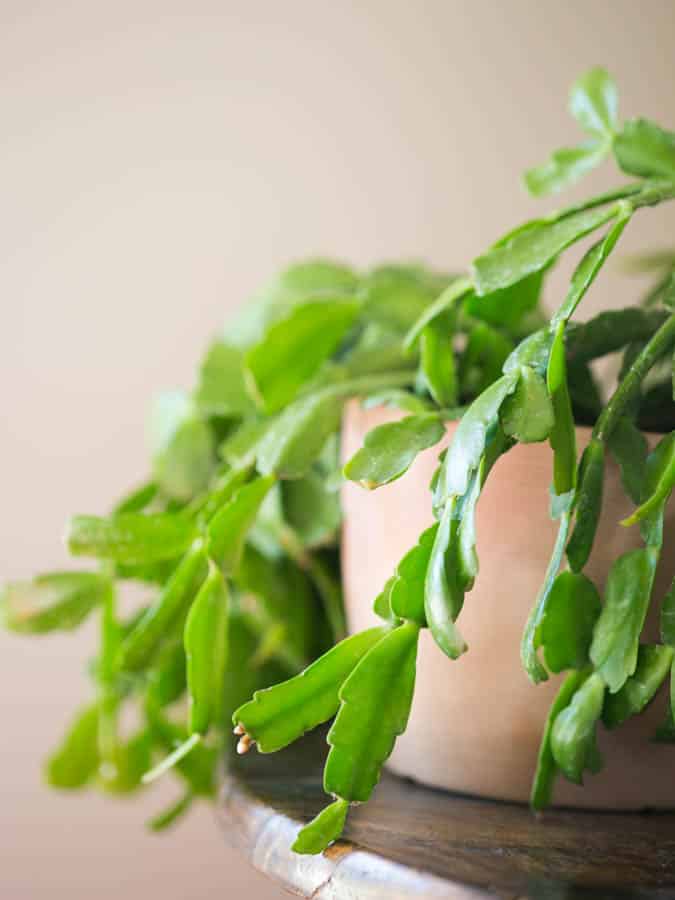
They do not receive direct sunlight in their shady native environments.
These Christmas plants can easily be grown indoors as a spectacular and impressive houseplant. When given proper care these vibrant succulents may bloom once in both winter and spring. They can have a very long life span, even up to 100 years!
As an added bonus, these holiday cacti can easily be propagated from their stem segments, resulting in lots of new plants to share and enjoy.
The Schlumbergera genus includes the popular indoor plants Thanksgiving cactus and Easter cactus.
This post contains affiliate links. If you click through and make a purchase, we may make a small commission at no extra cost to you.
Where To Find Christmas Cactus
Christmas cactus and Thanksgiving cactus are often sold interchangeably, but they are actually two separate plants.
This very afternoon I spotted a gorgeous Thanksgiving cactus boasting a Christmas cactus tag- they are often falsely advertised.

Luckily the care needs for these two plants are identical, and you can purchase both to have a succession of blooming holiday flowers.
To find a true Christmas cactus takes a little effort. They can sometimes be found at specialty garden centers, but more often are passed down from friends and family members or purchased on Etsy.
Use the shape of the leaf, bloom time and appearance of the flower in order to correctly identify Christmas cactus.
We have an in depth guide that will help you correctly identify holiday cacti here.
We found the beautiful Christmas cactus below at Tsagawa’s nursery in SW Washington. The best time to search for a Christmas cactus is in November through December, when holiday cacti are being sold for the season.

Christmas Cactus Care Guide
When grown as a houseplant, Christmas cactus must be given certain growing conditions in order to thrive.
Well draining soil is the top priority, followed by a consistent watering schedule, proper lighting, and the right temperature and humidity.
Get all the essential care details right here:
Watering
Key Takeaway: Water your plant deeply when the top layer of soil is dry, then allow it to dry out before watering again. Too much water and soggy problems will cause bacterial problems for the plant.
Christmas cactus benefit from a regularly watering routine, especially during the growing season. Water when the top two inches of soil is dry.
You can use a soil moisture meter, like this one, or simply insert your finger into the soil to see if their is moisture below the surface. Be careful not to disturb the plant’s roots!
If your plant is small enough, you can also pick up the container and see how heavy or light it is. A light cacti container indicates dry soil.
Water Christmas cactus plants deeply, until soil runs out of the bottom of the pot. Use a gentle stream of water at the base of the plant- water well but don’t flood your holiday cactus!
We recommend using a chemical free source of water for your houseplants, such as collected rain water.
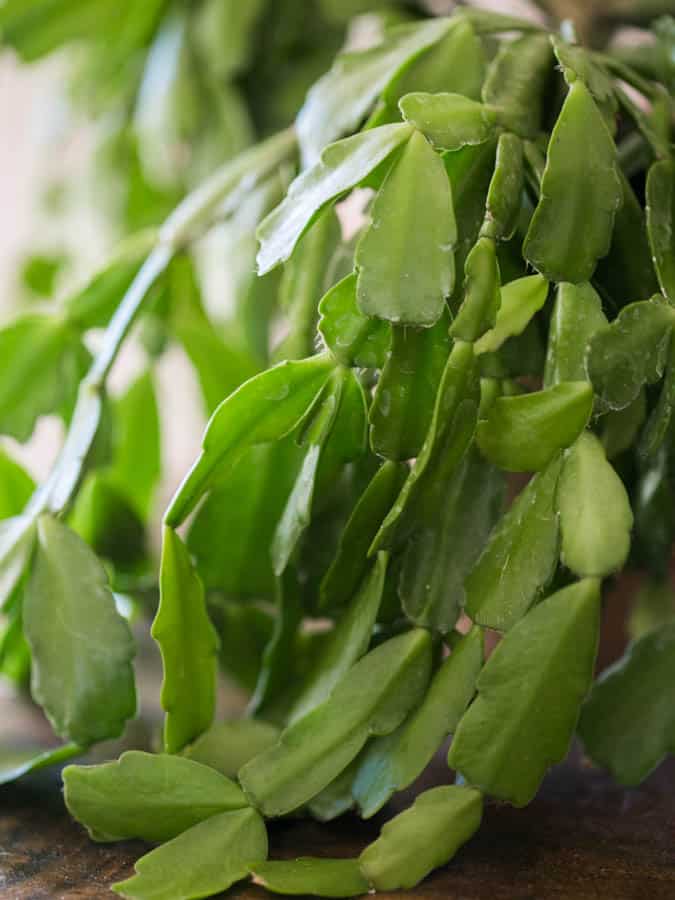
Overwatering holiday cactus is a common problem. Pesky fungus gnats, rotten stems and putrid soil can be caused by giving the cacti too much water. Conversely, not watering enough will stress your plant and cause the leaves to shrivel up!
Learn how to correct an overwatered Christmas cactus here.
Drainage
A good watering routine must be accompanied by a container that has drainage holes in the bottom of the pot.
These holes will allow the water to drain off the roots and prevent moisture build up that will lead to fungal disease like root rot.
If you purchase a holiday cactus with a decorative outer pot, be sure to remove it prior to watering. These festive outer containers often have no holes and will collect excess water, causing problems for your plant.
Potting Mix
Get our custom soil recipe for CC here.
In their native environment Christmas cactus grow as epiphytes in the coastal mountains of Brazil.
This means that they grow off of other plants: decaying plant matter found in the crevices of rocks or hanging from the bark and branches of other trees.

This native growing medium is very loose and well draining, and also full of nutrients. When grown as indoor plants these cacti need a well-drained soil that features really good drainage just like in their natural habitat.
The pH level in this soil substrate is slightly acidic, around 5.2-6.5.
This can easily be accomplished by combining one part potting soil to two parts orchid bark and perlite. Read our step by step instructions here.
All potting soil will eventually runs out of nutrients. Christmas cactus need to be re potted about once every three to four years, or when they outgrow their container.
Light
Christmas cactus do best in bright, indirect light. Remember that these tropical plants come from shady jungle areas, where the light is diffused.
Direct light can sunburn the leaves and damage the plant.
We currently have our Christmas cactus in a North facing room with a lot of windows – where lots of bright, indirect light falls throughout the day.

My mom has a south facing sun room, and we found her plant was getting too much direct light on the Christmas cactus leaves as the sun set in that location.
Sometimes you need to experiment with locations just a bit before finding the right spot that has enough bright light and no harsh direct sun rays.
Holiday cactus are short day plants, and they will need at least 12-14 hours of darkness each day in the fall to set their flower buds.
Humidity
Christmas cactus thrive in a humid environment with a level around 50-60%. Humidity levels vary based on your growing zone, the season and your specific environment.
While many home environments do not reach this humidity level there are a few easy hacks you can use to raise the levels in your home:
- Run a humidifier to raise the humidity levels near your plant
- Keep your cactus near an area with naturally high humidity, such as a bathroom
- Keep your houseplants grouped together to encourage the formation of a micro climate full of high humidity. According to Feline Jungle, this is one of the best ways to increase humidity levels.
Temperature
During the summer months holiday cactus are doing the most growth and love warm temperatures in the 70’s and 80’s.
As fall approaches, they will need cooler temperatures in order to set their buds, around 50-60 degrees Fahrenheit.
Fertilizer
The best time to feed a Christmas cactus is when it is actively growing, from late winter into late summer. Once it starts producing buds in the fall, you can stop fertilizing.
Holiday cactus benefit from a balanced fertilizer of 10-10-10 or 20-20-20 applied once a month. Dilute the fertilizer to half strength and apply at the base of the plant.
On an alternate week, feed your plant with a dilution of epsom salts, which helps meet the plant’s need for magnesium. Use one teaspoon per gallon of epsom salts.
We recommend Jack’s All Purpose soluble plant food, diluted to half strength and applied with every watering during the growing season. Read more about fertilizing holiday cactus here.

How To Get Christmas Cactus To Bloom
Christmas cactus are called short day plants because they need shorter days of light and cooler temperatures in order to bloom.
To encourage your plant to bloom, make sure it gets 12-14 hours of darkness per day with temperatures between 60 and 68 degrees for a period of 3-6 weeks in the fall.
Depending on your location and micro climate, your plant may already be receiving these optimal conditions for developing buds.
But if your cacti is not receiving enough night time hours, you can set it in a dark location, like a closet, for 12-14 hours per day. Some people opt to cover their plant with a dark cloth or bag.
Keep in mind bloom times can range, and it can be normal for a cactus to bloom a tad early or late.
Common Problems
Here are a few of the most common problems that occur with Christmas cactus and how to address them:
Root Rot
Fungal diseases like root rot can occur from over watering and damp conditions. These diseases will lea to limp leaves, black spots, and eventual death of the plant.
The best thing to do for your plant to be preventative in your approach. Encourage dry conditions by waiting until the top inch of soil is dry before watering, and making sure you have great drainage in the bottom of the container.
Fungus Gnats
Fungus gnats are attracted to overly moist conditions. As their name implies, they feast on fungal growth, but will also chomp into the roots of your plants.
Prevent a gnat infection by letting soil dry out before watering to prevent mold and fungus. You can treat an active infestation with these sticky bug traps.
Purple Leaves
Darkening, purple leaves indicates trouble with your cactus. They may be receiving too much direct light, have root rot, or may be in an environment that is too cold.
Failing To Bloom
A Christmas cactus can fail to bloom when it is not given enough hours of darkness for the buds to set.
Depending on where you live, you may need to encourage the plant to bloom by setting it a dark location for at least 12-14 hours a day. These short days will stimulate bud development.
Learn about the 10 most common problems and how to fix them here.

Final Thoughts
Christmas cacti are a popular houseplant that bring lots colorful flowers to the holiday season.
When given the right care these plants will thrive, adding a vibrant and natural element to your holiday decor.
These low-maintenance plants bloom at Christmas time and make excellent gifts for a host- or to enjoy yourself!
As always, leave us a note in the comments if you have any questions or comments!

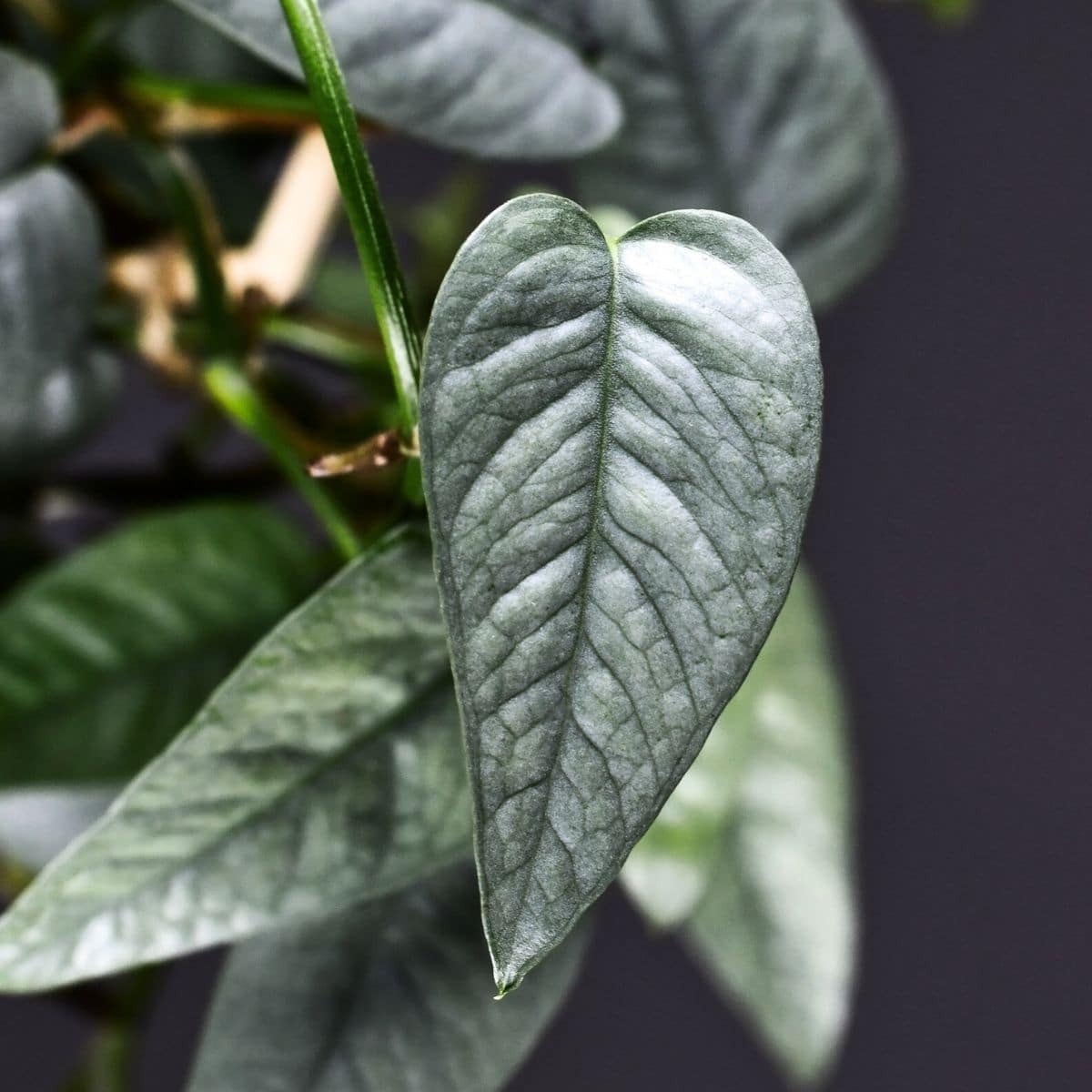
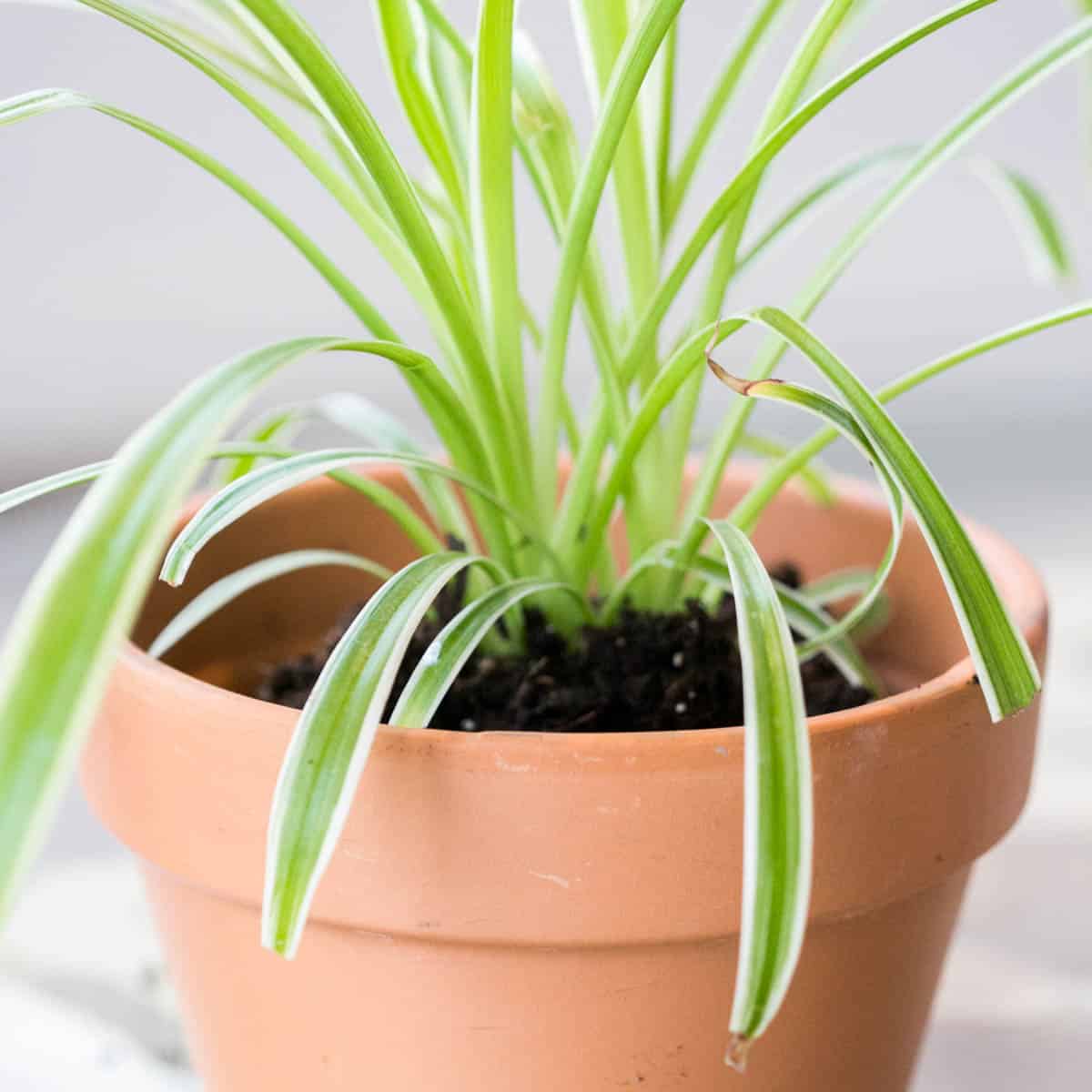
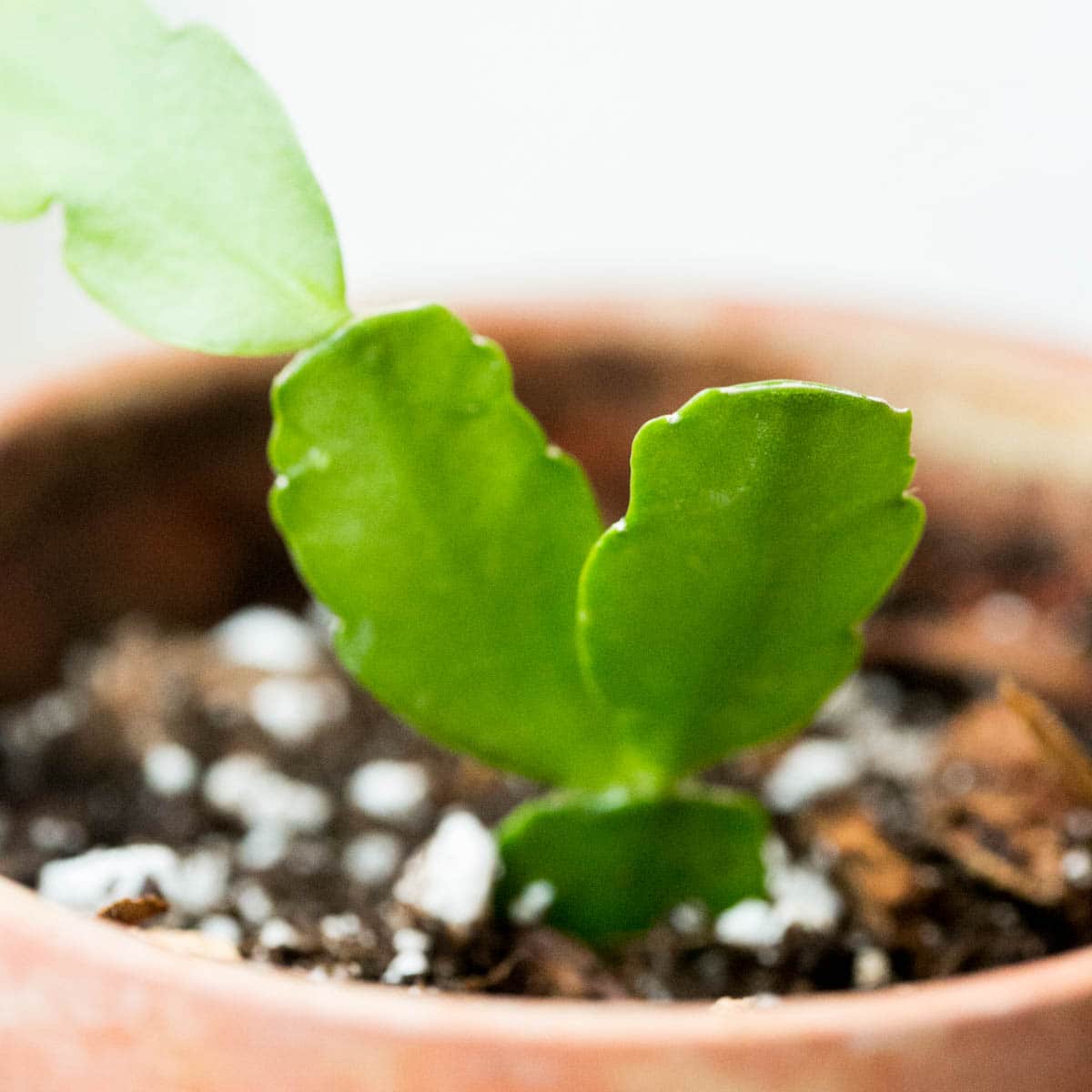

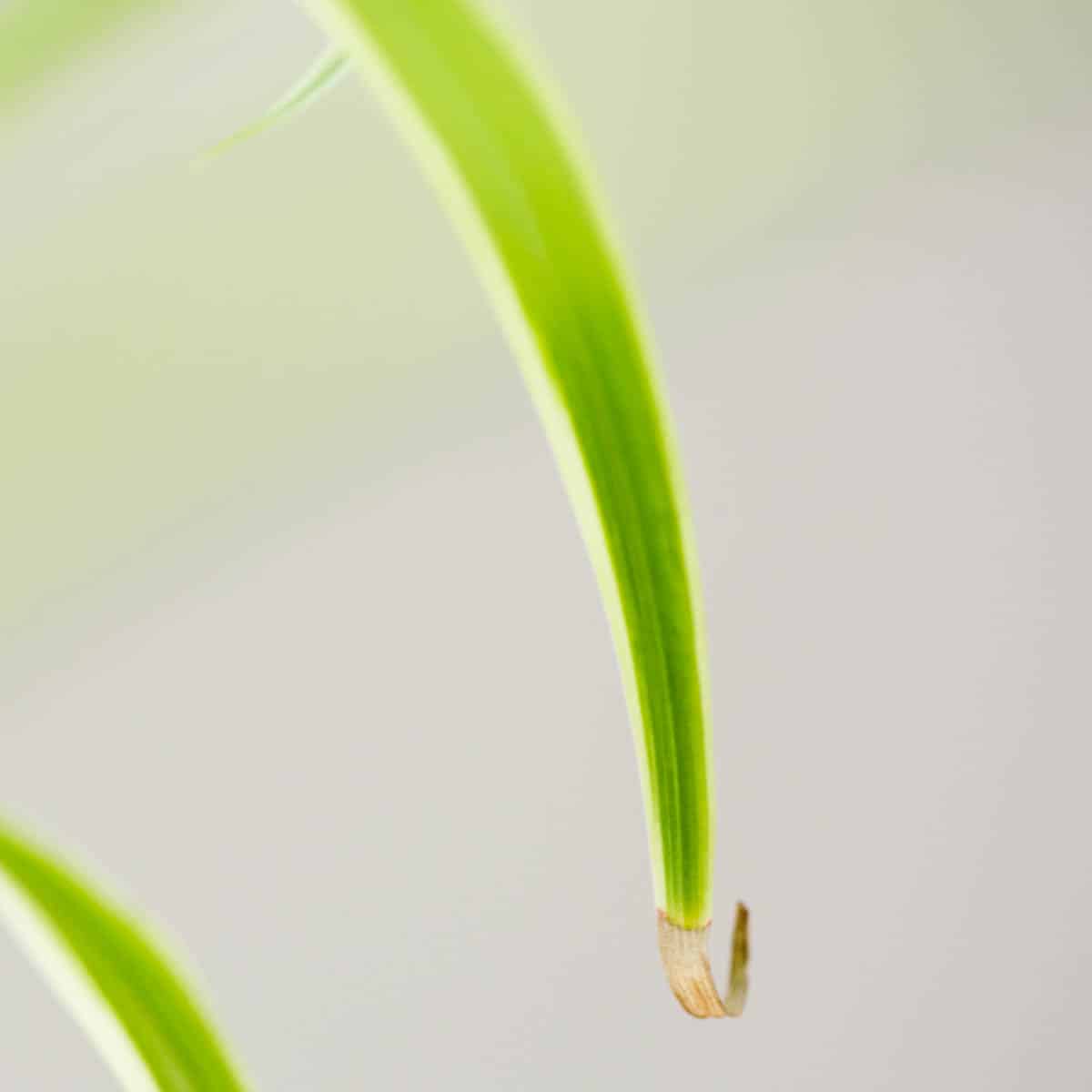
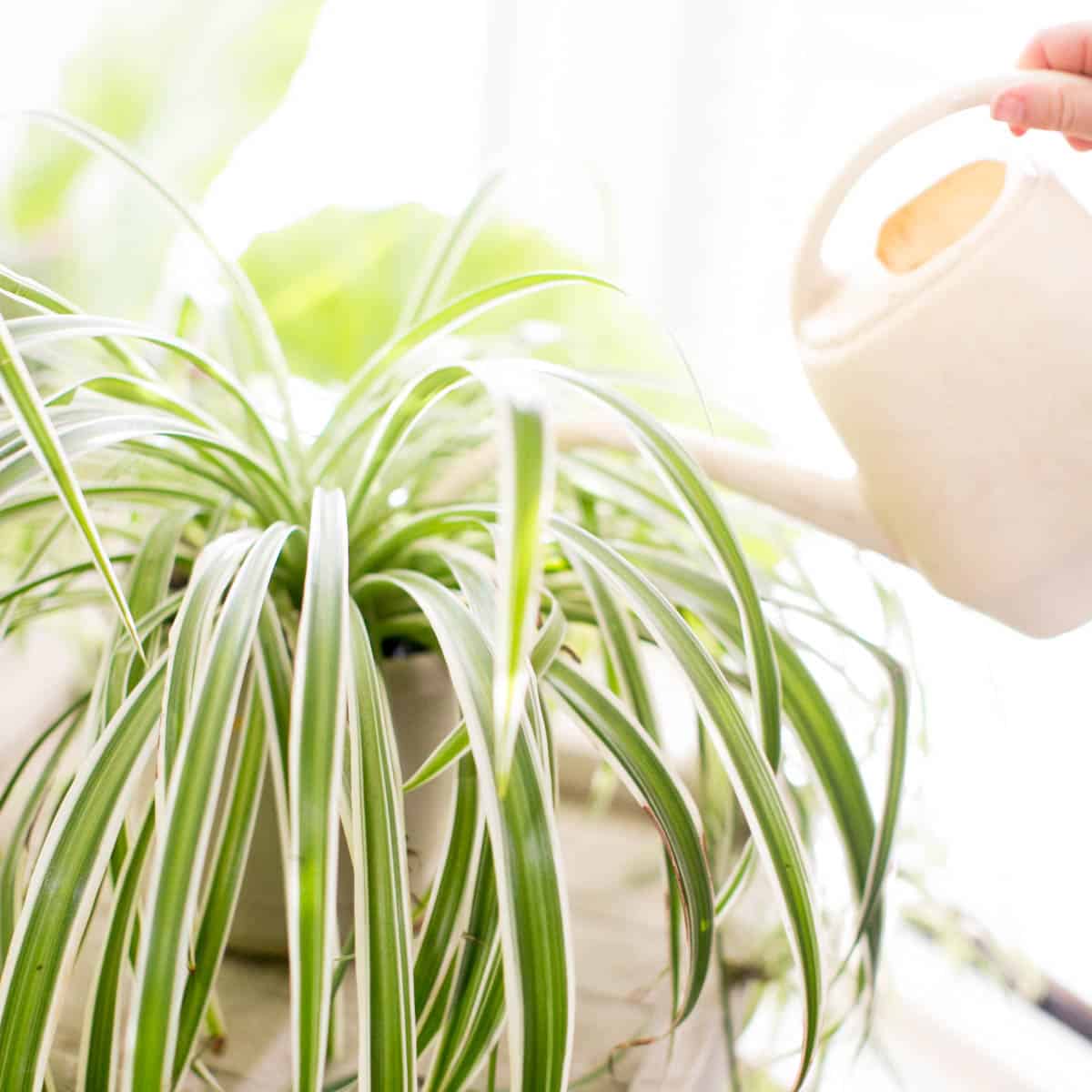
Thank you for all the great information. Mine always have bloomed. The weather in Florida has been so hot they put out so much new growth. It is now November can I still cover them to get some blooms.
Hi Lawana!
Yes, what I would do is make sure they get at least 12 hours of darkness a day. So if you have a room that stays dark all night/evening and gets daylight during the day, that is great. But if not, you may want to carefully cover them for the amount of time needed each evening. Cacti bloom time can definitely vary depending on the location and climate.
I have had my Christmas Cati one year. I put it in a dark room for a month and took it out thinking it would bloom but it did not. I have had Leaves dropping and that upsets me. I do not have areas of my house where light comes thru for this plant. So I now have it in my family room where I have a lot of fluorescent lighting throughout my house. I water in small amounts when I check the soil for dryness. So Help! Advise.
Pat.
Hi Pat. I need to write an article about this to make it more clear. So the goal of putting a Christmas cacti in a darker area would be to stimulate the natural light cycles the plant experiences in its native environment. So ideally you would want 12-14 hours of darkness per day, not complete darkness on the plant for a month. So instead of just putting the plant in a dark room with no light, try to find an area that receives light for 12 hours a day and dark for 12 hours. You could do fluorescent lighting and turn the lights off in the evening for 12 hours. Additionally, I would make sure you water the plant thoroughly, then wait for the soil to dry out, then water it again. So you may go a 10-14 days in between watering, rather than giving it little bits of water at a time. Make sure your container has drainage holes as well. I am going to write a post clarifying the lighting conditions CC need to bloom, there is a lot of confusion on this topic! let me know if this helps and I’m sorry your plant is struggling!
I have felt that in bad environment like loud noises screaming fighting couples always fighting plants don’t like that… My Christmas Cactuss and Thanksgiving Cactus were doing fine but then more screaming started up again and my cactuses started to die…Is that possible
Hi Catherine! I think it may be possible that energy effects the plants, good or bad. This is a hotly debated topic, there are a lot of various opinions about it on the internet and youtube. Regardless, I hope things get better for all very soon!
Awesome article! Thankyou! Do they need more light when they start to actually bloom? And if I move them to a different room when in bloom will the flowers start to drop off?
Hi Shari! Thank you! So the days will be shorter when they start to bloom, with less light- and you can just keep them in that light source! So to clarify, they may be in a room with window light from 7 am until 5 pm. Then from 5 pm to 7 am that room is dark. (Make sure to turn lights off, etc). This would be an ideal situation. You can move them if needed, just not too much as they don’t like to be fussed with a lot and it’s good to get them in a consistent spot with light and temperature. 🙂
Ok thankyou! I do have them in a room with those conditions but it’s a bedroom rarely used. I was just hoping when they bloomed, which one has buds on now, can I move it to a different room because no one will get to see those beautiful blooms unless I take them in there to see it lol. All my other spots I could keep it in get too much artificial light.
Hi Shari! Yes you definitely can move it to a spot where the plant can be enjoyed! Just try to find a spot that is similar in humidity and temperature. As long as you are not jostling it around or dancing to Christmas music the plant should do just fine. 🙂
Hi Jamie,
I have a Christmas cactus that blooms in the spring and in late November. It is beautiful. I also have an Easter cactus that hasn’t bloomed since I got it. Do you have any advice for me? The leaves are beautiful but no flowers.
Hi Sharen! Make sure the Easter cactus is getting cooler temperatures, especially around 50-55 degrees at night. They need equal amounts of light and darkness to bloom, so make sure that they receive around the same hours of darkness at night as daytime hours. Do this for a few months, then set the cactus in warmer temperatures (65 degrees) in January. Let me know if this helps!
I use a little sugar in my water, dissolve 1st.
Thank you for the helpful tips!
Thank you so much for stopping by Doreen! So glad you found the article helpful. 🙂
After care, I normally pinch off the dead spent blooms. How else can I preserve and protect the plant after blooming?
Hi Jan! After the plant goes through it’s bloom production it enters a period of rest. It will require less watering and doesn’t need to be fertilized. You can essentially just let your plant rest until the growing season begins!
Hi Jamie.
Thank you so much for all this awesome information. I inherited what I thought was a Christmas cactus from my late grandmother. But, now I know that it is a Thanksgiving cactus. It is very precious to me. I had a question about it’s blooming. There are what look to be three separate plants in one pot. All the sections bloom at different times. Is this normal or am I doing something wrong? Thank you again for this article. I really enjoyed reading it. And, thank you also for helping me identify what it actually is 🙂
Sincerely,
Lisa Martino
Hi Lisa! What a special gift from your Grandma! It sounds to me like there may be three separate plants growing in the container and yes this can be normal. As long as the plants are healthy and thriving I would not change anything! If you decide to re pot you could probably separate the plants, but so long as it is healthy I would probably just enjoy the extended bloom period! 🙂
It is so nice to see a article about Christmas cactus that actually has a pictures of Christmas Cacti… Now if I could just find a real Christmas cactus I would be all set!
Hi Lesley! Thank you so much for that feedback! I need to write a post on where to find Christmas cacti. I would look for a reputable grower on Etsy to send you some starts (check the reviews on the seller to make sure they are solid). I have also found luck going to small nurseries, but you’ll want to verify the plant is actually a Christmas cactus as they often market Thanksgiving cactus as Christmas cactus!
Thank you so much for the articles on both the Christmas cactus and the Thanksgiving cactus. I didn’t realize there were two types. I have two Thanksgiving cactus and one Christmas cactus. I have found that rooting then in water world best as it has more oxygen than just soil and roots faster.
Susan! Thank you so much for this valuable tip. We have found that they root pretty quickly in water as well. Thanks for sharing your experience!
I have 3 CC I just got a white one full of blooms and buds but now the buds are drying up and falling off. please help
Hi Dana! After blooming the flowers will dry up and fall off as part of their lifecycle. Is this what is happening?
This is a great article, and extremely helpful. Thank you! I have 2 CC (I think) and want to repot them. Do you suggest a particular pot to use? Thanks again!!!!!! Wishing you a wonderful 2024! Stay safe! Stay well!
Hello Debbie! Happy 2024! You as well, stay safe + happy! You can really use any material of container for your Christmas cactus, from ceramic to plastic. Make sure the container has drainage holes. Christmas cactus like to be slightly root bound so it’s best to just go one size up when re potting. Let me know if this helps and thank you for stopping by! To correctly ID your CC, make sure to check out our post on Thanksgiving cactus verses Christmas cactus! 🙂
Thank you! Your expertise is appreciated. This is my first year caring and loving my cacti.
Hi Sylvia! Thank you so much for stopping by, we are so glad to be of help. Keep us posted on how your plant does this year!
My CC ‘s have tons of blooms but most do not open and fall off before blooming. Help.
Hi Lisa! oh no I’m sorry. A few things can be at play here. First, overwatering can cause flowers to fall off. Secondly, temperature fluctuations can also affect the plant- try to keep a steady temp for day and night. Moving to a new environment can also upset the Christmas cactus and cause it to drop blooms.
What is the best time to propagate my thanksgiving cactus? I did it this past Sept and it went well but I didn’t get many blooms this year.
Thanks, great article!
Hi Paula! We recommend propagating Christmas cactus in the spring when the plant is actively growing and there are no blooms. Your plant will probably bloom more next year! 🙂